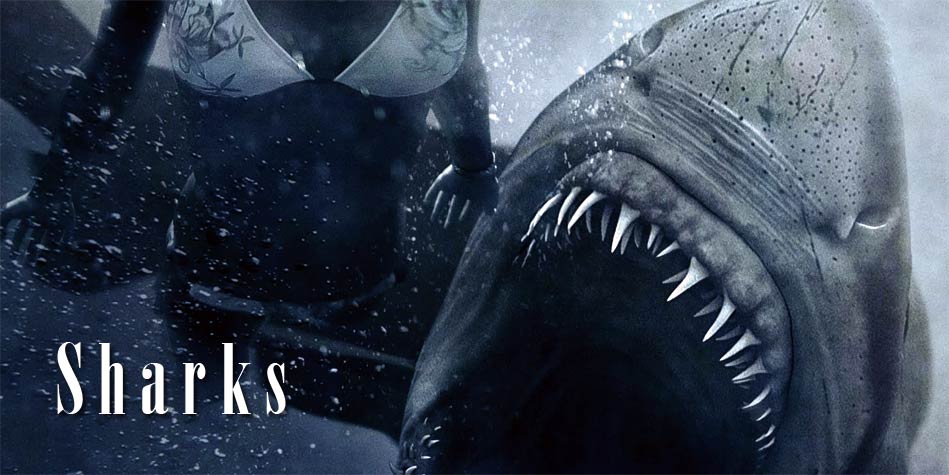Sharks – characteristics
There are over 500 species of sharks living in seas and oceans. Sharks have prevailed in theme for over 400 million years. They have witnessed the origins, development, and extinction of dinosaurs, they have observed the first birds, reptiles, and mammals. In addition, during their incredibly long history, they have briefly noticed the appearance of man. The question is, whether they will see our fall, or will not be able to… Although they have remained in almost the same form until today, human, this wonderful “intelligent” being, decided to play with them a survival game…
It is estimated that about 100 million sharks are killed by men every year. Most of them are fished commercially and recreationally. Many sharks are killed in an inhumane way – people only cut their fins off and the rest of the shark bodies are thrown overboard and go lifelessly to the bottom of the sea… What did sharks deserve for this massacre? Did they even deserve to be treated in such a ruthless and objective way?
They frighten many people, and that fear, in turn, triggers hatred and contempt. However, we hope that after reading this article, at least a few people will change their mind about sharks – beautiful, intelligent and incredibly diverse creatures.
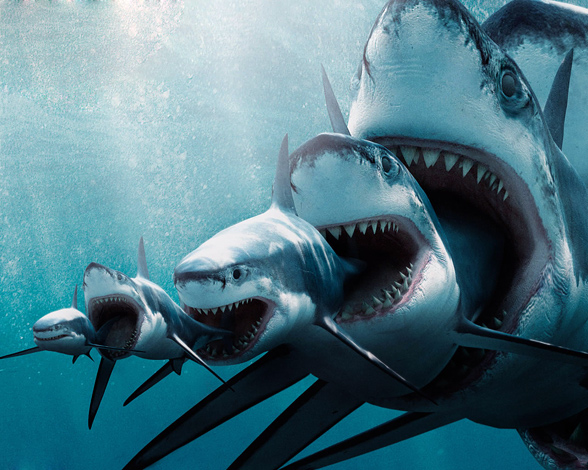
Classification
- Kingdom: Animalia
- Phylum: Chordata
- Class: Chondrichthyes
- Subclass: Elasmobranchii
- Infraclass: Euselachii
- Superorder: Selachimorpha
- Orders:
- Carcharhiniformes
- Heterodontiformes
- Hexanchiformes
- Lamniformes
- Orectolobiformes
- Pristiophoriformes
- Squaliformes
- Squatiniformes
- † Cladoselachiformes
- † Hybodontiformes
- † Symmoriida
- † Xenacanthida
There have been over 500 species of sharks classified so far.
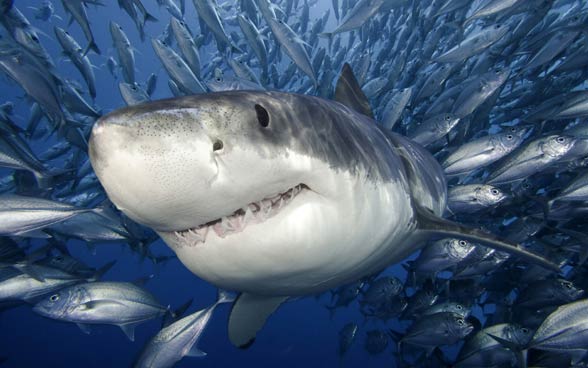
Occurrence
Sharks can be found in all seas and oceans. They generally prefer saltwater, although the bull shark (Carcharhinus leucas) can live in both rivers and seas, and the representatives of the ground sharks from the genus Glyphis are found almost only in fresh waters.
They are found at a depth up to 2,000 m (6,562ft), but some of them can live even deeper, 3,000 m (9,843 ft) underwater (an individual found at 3,700 m (12,139 ft) underwater was a confirmed record-breaker).

Shark anatomy
The shark’s skeleton is built of cartilage and connective tissue. Cartilage is very flexible and sturdy, but half less dense than the average density of bone. Thanks to that, the skeleton is lighter, and this, in turn, allows sharks to save more energy during swimming. Sharks have no chest, and therefore they can be easily crashed on the ground by their own weight.
Unlike bony fish, sharks are covered with a flexible skin creature composed of collagen fibers resembling cloves. It functions a bit like the external skeleton, to which muscles are attached. The shape of collagen fibers has many hydrodynamic advantages, because it reduces eddies occurring during swimming.

Fins
The fins are elongated and stiff. They are built of girdles and skeleton elements. The characteristic feature of many sharks is a big, triangular and salient dorsal fin that became the characteristic feature of all sharks worldwide. It always causes suspense and horror in movies.
Sharks are also equipped with characteristic vertical tail fins. However, their shape may be varied, depending on the species, because each of them has been adapted to living in a different environment.
Usually, the upper part of the tail fin is bigger than the lower part. It is because the spine of these fish extends from the upper part of the fin, which increases the area of muscle attachment. Thanks to that sharks swim more effectively, e.g. in the tiger shark (Galeocerdo cuvier), such a tail structure enables it to accelerate rapidly. However, for example, the porbeagle (Lamna nasus) is an exception, as it has a bigger lower tail fin, which enables the shark to catch up fast prey, such as the mackerel or herring.
Most sharks are built in such a way, so that they can catch their prey and not chase it. The sharks of the Alopias genus are exceptional in this respect, as they have a very elongated upper tail fin that is as long as the shark’s body. It serves as a stunning weapon – when the predator swims into the shoal of fish, it whips the water with the tail, which confuses the prey.

Jaws
In sharks and stingrays, the jaws are not attached to the skull. However, they are covered with specific, hexagonal tiles that strengthen the jaws, which enable them to generate strong bites.
In small sharks, there is only one layer of such tiles, but in big species, for example, the great white shark, tiger shark or bull shark, 2 or even 3 layers can be found, depending on the body size (in the jaws of very large great white sharks 5 layers of tiles may occur).
The cartilage that comprises the snout may be spongy and flexible to absorb the impact force.

Shark’s skin
There are many myths considering the shark’s skin.
At the first sight, the skin seems to be smooth. However, if you touched it, moving your hand towards the head, you would find out that it is actually as rough as sandpaper.
The shark’s skin is covered with small, grooved scales that cause such an effect. They help the shark in two ways.
The first one is the regulation of the flow of water, the scales enable the shark to swim in the water with small resistance. The second one is that when the shark is swimming, the scales undulate and that prevents parasites from settling on them.
Nowadays, people produce materials that have the characteristics of the shark’s skin. They have many uses – e.g. for swimming attires whose outside part imitates the texture of the shark’s skin, which increases the speed of swimming by several percent.
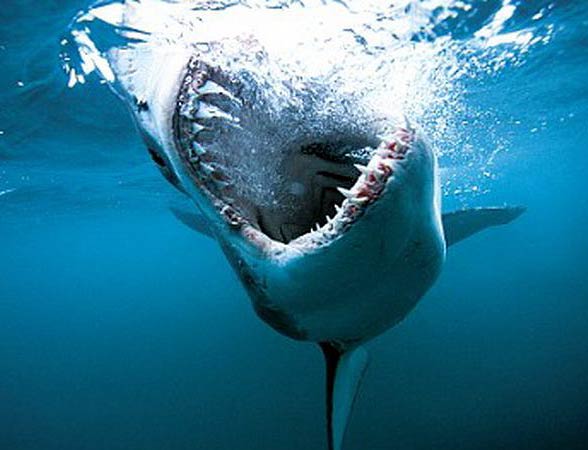
Teeth
The shark’s teeth are embedded in the gums, but they are not attached to the jaws directly. When they fall out, they are replaced with new ones. This cycle repeats throughout the whole life of a shark. The teeth make several rows. Usually, one tooth is replaced at a time, but in the Squaliformes from the Isistius genus a whole row can be replaced at a time.
The shape of the teeth depends on the diet of a given shark – the amateurs of shellfish and protostome have densely placed, flat teeth adapted to crushing. Sharks that hunt fish have needle-like teeth used for grasping, and those hunting larger prey, including aquatic mammals, have a more diverse set of teeth: lower teeth are to catch prey, and the upper teeth are triangular and their edges are serrated, used for cutting.
In herbivorous species, the teeth are small and hardly used.
Throughout its life, a shark may lose even 30,000 teeth. This number depends on the species.
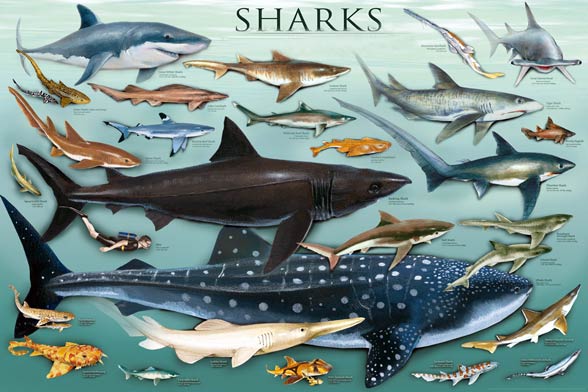
Senses
Sight
The eyes are built similarly to the eyes of other vertebrates, but they are additionally adapted to seeing in the water. It is enabled by the so-called tapetum lucidum.
In many shark species, the pupils widen and narrow, which does not occur in the bony fish. Sharks also have eyelids, but they do not blink, because the eyes are cleansed by the surrounding water.
Nevertheless, in several species, an additional membrane, namely, the third eyelid, that protects the eyes during swimming or when a shark is being attacked, has developed. Those sharks that lack this third eyelid, e.g. the great white shark, roll their eyes backwards when they attack their prey. In addition, there are indications that a shark can “switch” its sight from monocular to stereoscopic and the other way round.
Sharks can see in the dark 10 times better than human.
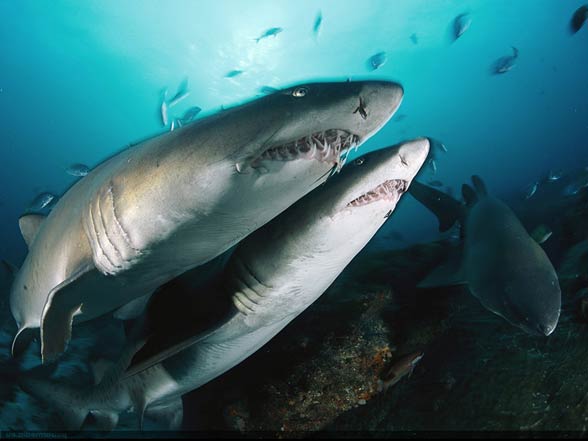
Smell
The sense of smell in sharks is very sensitive. Due to the structure of the whole olfactory system that is responsible for the sense of smell, some of these fish may detect 1 drop of blood in a million drops of seawater.
The shark’s smell has one more advantage; this animal can detect the direction from which a given smell comes. In this respect, sharks are very similar to mammals.
Hearing
It is not known for sure, but it is suspected that sharks’ hearing is very good. It can be that these predators can hear their prey from many kilometers away.

Electroreception, i.e. the electric sense
The ampullae of Lorenzini are responsible for this sense. There may be even several hundred thousand of these organs in one individual. As you can guess, they enable a shark to detect changes in the electromagnetic field generated by all living beings on Earth.
The electrical sense helps a shark detect its prey, particularly, it is inevitable in the hammerhead shark (Sphyrnidae).
It is pointless for the potential prey to hide in the sand – sand cannot hide the electrical impulses produced by fish. Apart from detecting prey, the ampullae of Lorenzini can also be a navigation tool. They are sensitive to sea currents in the magnetic field of Earth. This field and currents also generate the electrical field.
Lateral line
Thanks to the lateral line, the animal may detect movement and vibrations in the water. A shark senses frequencies ranging 25-50 Hz. Most fish have the lateral line.

Eating habits
A great number of sharks are carnivorous, although the way of obtaining food is diverse.
The whale shark – the largest shark and fish in the world, is a typical filter feeder that sucks plankton and small fish in. It has “whalebones” (a sieve) that are found in many whales. The megamouth shark feeds similarly, however, it can also lure its prey with the luminescence of tissue inside its mouth.
The cookiecutter shark (Isistius brasiliensis) has large teeth in relation to the shark’s size, and the lower teeth are exceptionally sharp. It seems that during hunting the shark grasps its prey, holds it and sucks in the body with its thick lips and bites off a piece of meat.
Species living at the bottom of the sea can hunt by ambush thanks to their camouflage. It concerns mostly carpet sharks of the family Orectolobidae and the family Squatinidae in the genus Squatina. Many demersal species feed only on shellfish that they crush with their teeth. Large species such as the great white shark eat small prey in whole, and they bite large pieces of meat off bigger prey. Some sharks prefer hunting gregariously, e.g. the white reef shark (Triaenodon obesus).

Lifestyle
People often think of sharks as of solitary hunters. This belief is only partially true, because only several species are solitary. Most sharks are very social.
Many of them also swim across many thousand kilometers searching for food and breeding grounds. Scientists believe that the migration patterns of sharks are more complex than those of birds are.
Some of the hammerhead sharks are among the most social sharks. They can form schools consisting of about 100 individuals gathering near underwater mountains and islands.
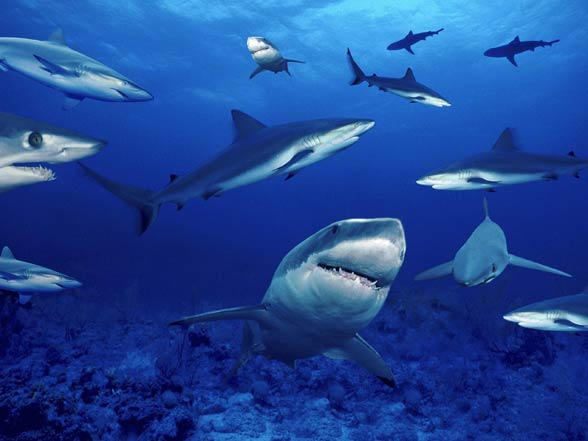
Buoyancy
Contrary to bony fish, sharks do not have the gas-filled swim bladder that enables buoyancy. These predatory fish need to cope with it in another way. To maintain depth while swimming, they use their large liver filled with an oily substance containing squalene. Their cartilaginous, light skeleton also helps them swim.
Most sharks have to swim all the time in order to breathe and not to fall on the bottom. However, there are species that are able to pump the water through their gills without movement, they can rest on the floor of the body of water. The lucky sharks include the nurse shark (Ginglymostoma cirratum).
Reproduction
Sharks use the K-selection strategy, which means that they have a small number of young at a time that have a bigger chance of survival until they are mature. These fish, however, mature slowly in comparison to other fish, for example, the lemon shark (Negaprion brevirostris) reaches sexual maturity only at the age of 13-15 years.
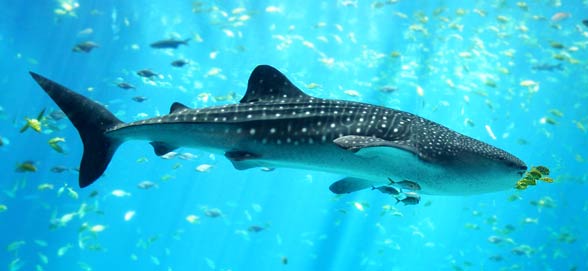
Types of fertilization
Sexual
It occurs inside the female’s body. The male uses his intromittent organ situated on the bottom part of the body. It is an equivalent of a mammalian penis. Usually, copulation is not preceded by mating.
Females of large species often have bite marks after copulation that is a “remembrance” of a male that held its mate with its teeth during the sexual act.
It is suspected that similar marks may be left after mating – males show their interest in a given female by biting. What is interesting, in females of some species, you can find thicker skin that protects them from this kind of injuries.
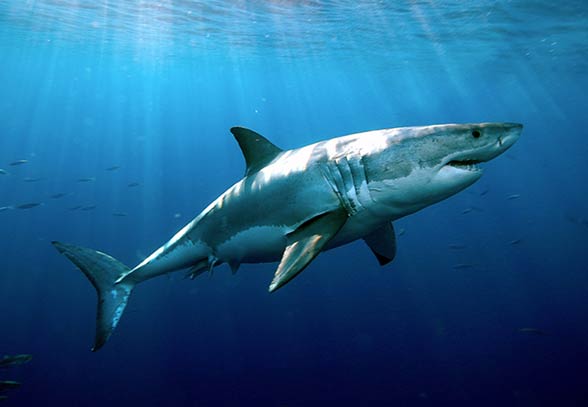
Asexual
Among sharks, there were two times when females have conceived young without contact with a male. Therefore, it turns out that the phenomenon of parthenogenesis may occur in these fish. Scientists believe that this type of fertilization is “the last resort” in a situation when there is no male shark around that would be willing to copulate.
Asexual reproduction, however, results in smaller genetic diversity that is inevitable for protection from hazards. It may seem that asexual reproduction could have contributed to the diminishment of the Irish population of the blue shark (Prionace glauca).
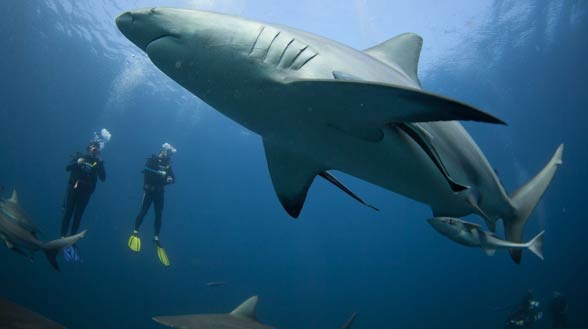
There are three types of bearing young among sharks:
Ovoviviparity
Ovoviviparity – occurs in the majority of sharks. After fertilization, eggs with yolk and fluids nourishing the embryo develop within the mother’s body. When the moment of birth comes, the pup is fully developed. In the Lamniformes, oophagy occurs – the first embryos that hatched within the female’s body eat the unhatched eggs. In the sand tiger shark (Carcharias taurus), the young eat their siblings.
Oviparity
Eggs are laid in the water. The young are protected by a leathery case. Empty eggs may often be seen on beaches; they are shaped in a characteristic way (sometimes they are called a mermaid’s purse). The oviparous shark species include: the catshark (Scyliorhinidae), horn shark (Heterodontus francisci) and Port Jackson shark (Heterodontus portusjacksoni).
Viviparity
Some species develop a placenta during gestation. The young are born fully developed. The viviparous sharks include mainly requiem sharks, including the abovementioned blue shark, and the representatives of the genus Mustelus.
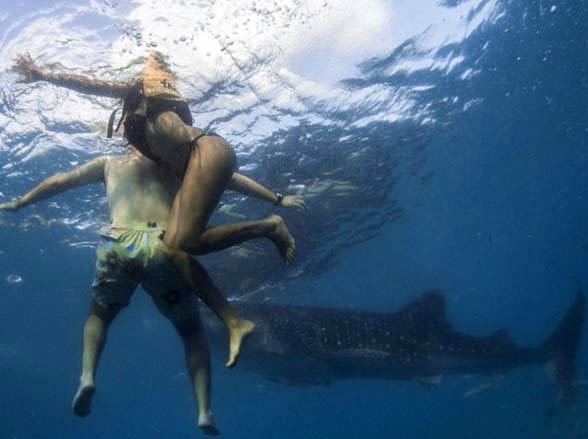
Shark attacks on people
In 2006, The International Shark Attack File – the international database gathering information about shark attacks on people verified 96 alleged attacks. 62 of them were unprovoked attacks, and 16 were caused by human intrusiveness. The average number of fatalities in 2001-2006 caused by an unprovoked attack is 4.3.
The above results prove that there are only a few shark species dangerous to humans. Among about 500 species, only 4 were associated with the most of the fatal, unprovoked attacks.
Sharks that are dangerous to humans
Sharks, to be afraid:
- great white shark
- oceanic whitetip shark (Carcharhinus longimanus)
- bull shark
- tiger shark
At the same time, these sharks are among the biggest sharks and due to their need for hunting large prey, they may attack and kill people. The issue of whether we are tasty to them has been explained in the article about the great white shark, also called a “man eater”.
One of the ways to avoid a shark attack is to take off any jewelry and metal elements before swimming in the sea/ocean, that glitter in the water. You should not also splash around too much because it provokes large sharks to attack.
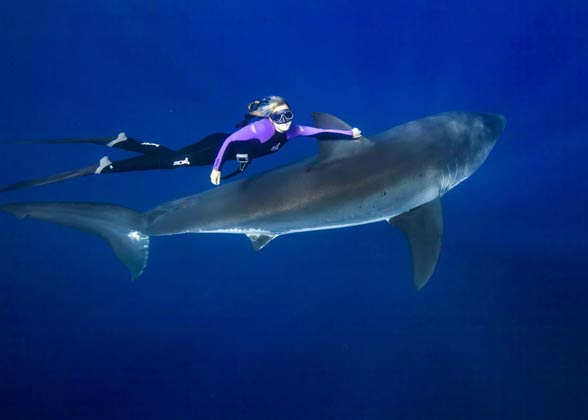
The shark with the longest lifespan
The shark with the longest lifespan and at the same time the vertebrate with the longest lifespan is the Greenland shark (Somniosus microcephalus). These sharks are able to reproduce at the age of 134-178 years… The maximum estimated lifespan is 392 years ± 120 years, which gives a minimum of 272 years and maximum of 512 years… This study was conducted on a 502 cm long female. The results were published in August 2016.
Detailed information / size
Sharks
- Body length: 0.17 – 12.65 m (0.56 – 41.5 ft), unverified to 20 m (66 ft) – the smallest known shark is a poorly studied representative of the Squaliformes from the species Etmopterus perryi. The largest shark in the world is the whale shark (Rhincodon typus).
- Weight: to 13.6 t (unverified to 20 tons)
- Lifespan: 20-100 years and longer, the age of the shark depends on the species. Greenland sharks are sharks with the longest lifespan, their maximum longevity was estimated at 272-512 years (the mistake resulting from the inaccuracy of estimation by radiocarbon dating).
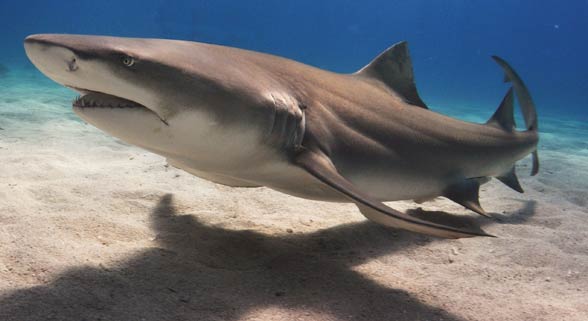
Sharks – interesting facts
- Can sharks be found in the Baltic Sea? We have answered this question in the article: Sharks – killers from deep waters.
- The oldest fossils of sharks are dated back to the Ordovician age, i.e. 450-420 million years ago. Thus, they had existed even before land vertebrates developed and plants colonized Earth.
- Sharks were found in the hot water surrounding the underwater volcano Kavachi situated in the southwestern Pacific.
- Throughout its life, a shark may lose even 30,000 teeth. This number depends on the species.
- Sharks can see in the dark 10 times better than humans.
- Most sharks are cold-blooded. It means that the temperature of their bodies is the same as the surrounding environment.
- Some sharks can use so-called apparent death. It is a method of defense from an enemy. A shark that is turned or touched on the nose becomes immobile as if it was dead.
- The body mass index to the brain mass in sharks is similar to birds and mammals. It means that they are intelligent which in the wild is manifested by behaviors indicating playfulness.
- The liver may be about 30% of a shark’s body mass.
- Sharks are present in Hawaiian mythology.
- Until the 16th century, sailors called sharks sea dogs/wolves.


